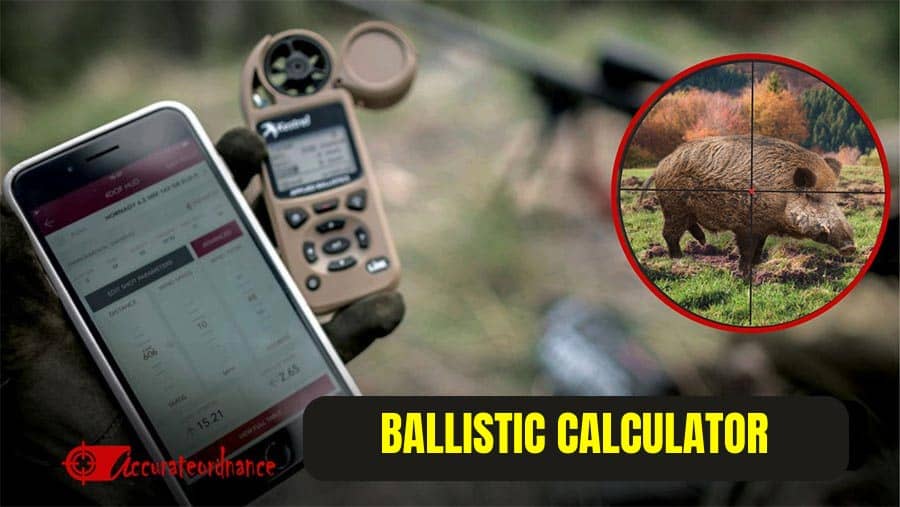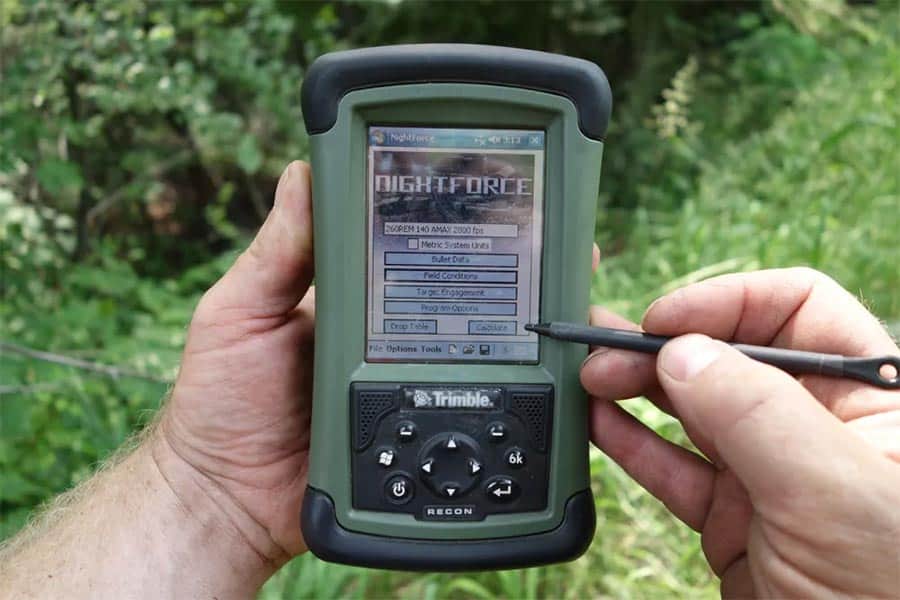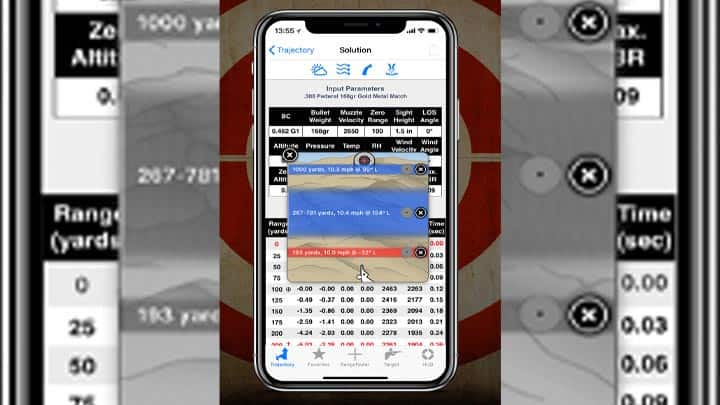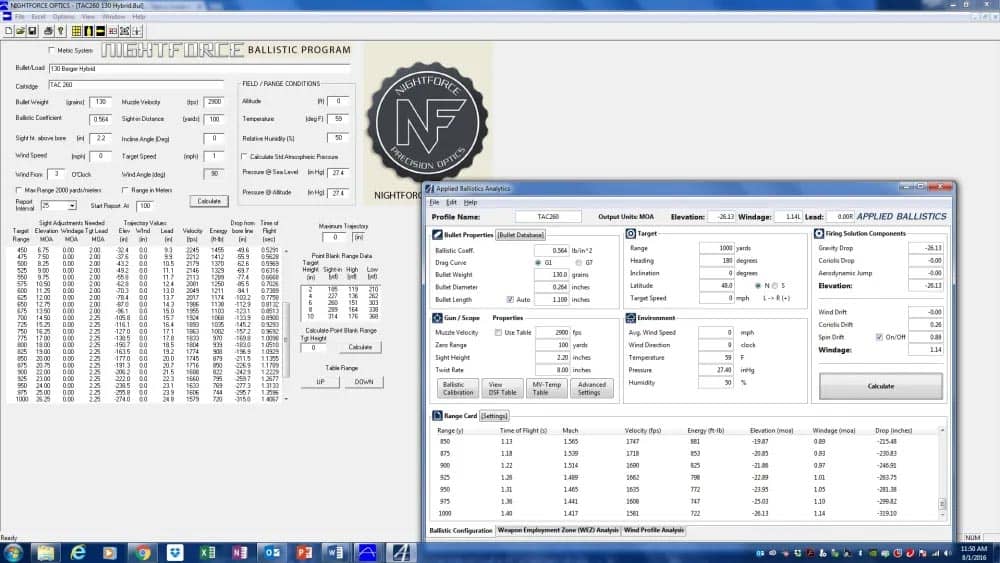Are you looking to improve your accuracy and shooting range? Have you ever considered using a riflescope with a ballistic calculator? This powerful combination can be a game-changer for you as a hunter, competitive shooter, or firearm enthusiast. Let’s dig deeper!
As technology advances, so do the tools available to long-range shooting enthusiasts. One such tool is a ballistic calculator, which can significantly improve shooting accuracy by predicting the trajectory of a bullet and providing valuable information to make necessary adjustments to hit targets accurately at various ranges and environmental conditions. In this post, we will explore the benefits of using a riflescope with a ballistic calculator, the types of ballistic calculators available, their pros and cons, and how to use them effectively. We will also discuss the factors to consider when selecting a riflescope for use with a ballistic calculator.
- What is a ballistic calculator?
- Why use a ballistic calculator?
- Types of ballistic calculator
- CONS of using a ballistic calculator
- How to Use a Ballistic Calculator
- Factors to Consider When Choosing a Riflescope
- Input Variables In A Ballistic Calculator
- Cleaning and Storage for Scopes with Ballistic Calculators
- Battery Replacement
- FAQs
- How does a Ballistic Calculator work?
- Can I use a Ballistic Calculator for different types of ammunition?
- Can I adjust the Ballistic Calculator settings for different shooting environments?
- Is it necessary to zero my riflescope when using a Ballistic Calculator?
- How accurate are the Bullet Trajectory calculations provided by the Ballistic Calculator?
- Can I use a Scope with a Ballistic Calculator for hunting purposes?
- Are Ballistic Calculators integrated directly into the scope, or do I need a separate device?
- What type of information do I need to input into the Ballistic Calculator for accurate trajectory predictions?
- Is using a Ballistic Calculator difficult, or can anyone learn to use it effectively?
- Are there any additional accessories or equipment needed to use a Ballistic Calculator and scope effectively?
What is a ballistic calculator?

A ballistic calculator is a tool used to determine the trajectory of a bullet fired from a firearm, taking into account various factors such as bullet weight, velocity, and air resistance. It uses advanced algorithms to calculate the bullet’s flight path, including drop and drift, as it travels toward the target. A ballistic calculator can also factor in environmental variables such as wind speed and direction, temperature, and altitude. This information is then used to adjust the aim point to ensure that the bullet hits the target accurately.
Ballistic calculators can come in the form of handheld devices, software applications, or even be integrated into some riflescopes. They are most useful for long range shooting, where slight deviations in the aim point can significantly affect the bullet’s trajectory and point of impact. With this tool, shooters can now accurately predict where their bullet will land, increasing their chances of hitting their target.
Why use a ballistic calculator?
The primary reason to use a ballistic calculator is to increase the accuracy of a shot, particularly over long distances. When shooting at a long-distance target, so many factors can affect your accuracy or bullet trajectory. Some of the factors include the caliber and weight of the bullet, the velocity at which it is fired, the atmospheric conditions (such as temperature, air pressure, and humidity), and the angle of the shot. There’s only one way to hit your target accurately and stop all these factors from affecting your accuracy and that is using a ballistic calculator.
Aside from better accuracy, ballistic calculator can also save time and ammunition because it allows shooters to calculate their shots before firing, reducing the need for excessive trial and error. Additionally, this tool can provide valuable information for reloading ammunition, as it allows reloaders to fine-tune their loads based on the performance of the bullets in different atmospheric conditions.
Also, with a ballistic calculator, you are sure of a better shooting experience. Shooting will be more fun and relaxing when you are more confident in your shot placement.
Types of ballistic calculator
There are several types of ballistic calculators available on the market, as we mentioned earlier, each with its unique features and benefits. Here are some of the most common types:
Handheld Calculators
Handheld ballistic calculators or ballistic solvers are portable electronic devices used to calculate the trajectory of a bullet. These standalone devices are often pre-loaded with ballistics data for a wide range of firearms and ammunition, making them useful for hunters and shooters on the go.
Handheld ballistic calculators are easy to use, with a simple interface that allows shooters to input the necessary data for their shot. Once the data is inputted, the calculator uses complex algorithms to provide the shooter with the necessary adjustments for their sights or scopes to hit the target accurately.

Smartphone Apps
Many companies offer ballistic calculator apps that can be downloaded onto smartphones. These apps typically have similar features to handheld calculators but are more convenient for shooters who always carry their phones with them.
Smartphone ballistic calculators are software applications that you can download on a smartphone or tablet to calculate bullet trajectories. These apps work like handheld ballistic calculators but are often more convenient and accessible. Smartphone ballistic calculator apps are often free or low-cost and can be easily downloaded from app stores. They also have a simple interface for inputting data.

PC Programs
PC ballistic calculators are software applications that can be installed on a personal computer or accessed via the internet to calculate a firearm and ammunition bullet trajectory. These programs are similar to smartphone calculators but are often more advanced and feature-rich, with extensive customization options like the ability to input more detailed information about the bullet, firearm, and environmental conditions, as well as advanced features like custom drag models or multi-point ballistic solutions. Additionally, some programs offer features like printable ballistics tables or integration with external devices.

CONS of using a ballistic calculator
Ballistic calculators can be a buzzkill for some shooters; if you’re a shooter who loves to live on the edge and rely on your instincts, a calculator might feel like cheating. You might miss out on the thrill of taking an uncertain shot and hitting your mark through sheer luck. Well, that’s for those that pleasure in gambling with their shots.
Another reason some people do not prefer a ballistic calculator is that it can make them complacent. If you rely too much on the calculator to do the work, you might become lazy and lose your edge as a shooter. After all, shooting is a skill; like any other skill, it requires practice and honing.
One more downside to using a ballistic calculator is that it can be a crutch. Over-dependence on the calculator will not help you develop a solid understanding of the fundamentals of ballistics. This can limit your ability to adjust on the fly and make critical decisions in the field.
Finally, a ballistic calculator can be a bit of a hassle. Sure, the calculators are designed to be user-friendly, but they still require you to input a lot of data, which can take time and attention away from other important aspects of shooting, like observing your surroundings and staying alert.
How to Use a Ballistic Calculator
Using a ballistic calculator involves several steps. Here’s a general guide on how to use this calculator:
Set up the Riflescope
You cannot take about a ballistic calculator without mentioning a riflescope. To use this tool, you have to first mount the riflescope on your firearm and zero the scope at your desired distance.
Gather Information
After setting up the scope, you need to gather information about the firearm and ammunition you are using. This includes details like the caliber and weight of the bullet, the muzzle velocity, and atmospheric conditions like temperature, air pressure, and humidity. If you’re unsure where to find this information, refer to the manufacturer’s specifications or consult a reloading manual.
Input Data
Once you have all the necessary information, it’s time to input it into the ballistic calculator. Most calculators will require you to input data like muzzle velocity, bullet weight, sight height, and atmospheric conditions. Some calculators may also ask for more detailed information, like the ballistic coefficient or the specific drag model of the bullet.
Adjust Settings
If you are done inputting all the necessary data, you can proceed to adjust the settings of the calculator to match your shooting conditions. This might include selecting the distance you want to shoot at, adjusting for wind or other factors, or choosing between different reticle options or metrics.
Get Results
After you have adjusted the settings, the ballistic calculator will generate a set of results that will help you make the necessary adjustments to your scope. This might include information about bullet drop, wind drift, or the necessary elevation or windage adjustments for your specific firearm.
Practice!
Now that you have your results, it’s time to put them to the test. Head out to the range or your favorite hunting spot and start shooting. Use the ballistic calculator to help you make the necessary adjustments and see how accurate you can be. Remember, shooting is a skill that takes practice to improve.
Factors to Consider When Choosing a Riflescope
Choosing a riflescope for your ballistic calculation is an excellent investment for long range shooting enthusiasts. Here are some critical factors to consider when selecting a riflescope:
Magnification Range
The reason you needed a ballistic calculator is most likely because you want to perform long-range shooting. And when it comes to this kind of shooting, the magnification range of the riflescope is an important consideration. A higher magnification will provide greater accuracy at longer ranges but may not be necessary for shorter distances.
Quality of Optics
The optics quality is crucial for accurate shooting. Look for high-quality glass, lens coatings, and lens construction so you can be sure of reduced distortion and a clearer image.
Reticle Type
Reticle type is also important when picking a riflescope. Some reticles have built-in range-finding capabilities, while others are designed for holdover aiming. Consider your shooting needs and choose a reticle that matches your preferences.
Battery Life
For those that would be doing their long-range shooting in low light conditions, you might need an illuminated reticle or other electronic features, making battery life an important factor. Look for scopes with long battery life or easy-to-replace batteries.
Durability
The riflescope you’re using for long distances should be built to withstand the rigors of outdoor use, including extreme temperatures, moisture, and impact. Get a scope that is made from high-quality materials and with excellent durability.
Input Variables In A Ballistic Calculator
Bullet Caliber
The caliber is the diameter of the bullet, measured in either inches or millimeters. It’s important to know the caliber of your bullet when using a ballistic calculator because it affects the bullet’s flight path and how it interacts with the air around it. Just like how different people have different shoe sizes, different bullets have different calibers!
Bullet weight
The bullet weight refers to the mass of the bullet, measured in grains. This ballistic input data affects how the bullet performs as it flies through the air. Heavier bullets are usually less affected by wind, while lighter bullets travel faster.
Muzzle velocity
When you take a shot with your firearm, the speed at which the bullet leaves the gun barrel is called muzzle velocity, and it is measured in feet per second (fps) or meters per second (mps). Muzzle velocity is an important input variable because it affects the time it takes the bullet to reach its target. A higher muzzle velocity generally means the bullet will travel faster and experience less drop over distance. This value is needed to calculate the ballistics of the bullet.
Sight Height
To get the sight height for your ballistic calculation, you have to measure the distance between the bore’s center and the scope’s centerline. This metric affects how the bullet travels its path relative to the scope’s line of sight when you aim with the ballistic reticle.
Atmospheric condition
There are three major variables to consider in the atmosphere when shooting: temperature, air pressure, and humidity. These variables can affect your bullet performance as it travels through the air.
Temperature
Temperature is pretty straightforward – it’s how hot or cold it is outside. But why does this matter? Well, temperature affects the density of the air, which in turn affects the bullet’s flight path. In general, colder air is denser, which can cause a bullet to slow down and drop more quickly. Warmer air is less dense, which can cause a bullet to travel faster and drop less over a distance.
Air Pressure
Air pressure is the weight of the air pushing down on us, measured in either inch of mercury or millibars. Air pressure affects the density of the air just like temperature does, so it can also affect the bullet’s flight path. Higher air pressure means denser air and lower air pressure means less dense air.
Humidity
Humidity is the amount of water vapor in the air. This variable is a bit trickier to understand, but the basic idea is that more humid air is less dense than drier air.
So, why does all of this matter? When you input the atmospheric data in your ballistic calculator, you can make more accurate predictions about how your bullet will perform in the air.
Altitude
Altitude is simply the height above sea level. Why does it matter? Well, the higher you go, the thinner the air gets. This can affect the bullet’s flight path in a similar way to temperature and air pressure – higher altitude means less dense air.
Wind speed and direction
The term wind speed and direction is self-explanatory. The wind can make shooting more challenging, but it also adds a fun element of unpredictability. Even a small amount of wind can cause a bullet to drift off course, so it’s important to factor in wind when using a ballistic calculator.
Zero Range
The zero range here is the distance at which you have zeroed your scope. Shooters zero their scopes at different distances, but most zero at 100 yards for medium-distance shooting and 25 yards for short-range shooting. Input the zero in your ballistic calculator to get a more accurate calculation.
Angle of inclination or declination
This variable refers to the angle of your shot – in other words, whether you’re shooting uphill or downhill. Shooting at an angle can change the effective range of your shot and the amount of bullet drop. This is because gravity affects the bullet differently depending on the angle of the shot.
Ballistic coefficient (BC)
The ballistic coefficient (BC) or drag coefficient of the bullet deals with the way the bullet cuts through the air. A bullet with a high BC or low drag coefficient will travel farther and with less drop. The shape and weight of the bullet determine the BC.
Target distance
Finally, we have the target distance. Target distance may not necessarily be entered into the ballistic calculator. You can estimate the target distance by using a range-finding ballistic reticle or using a range finder. The farther away the target, the more bullet drops you will need to account for, and the more wind drifts you will need to compensate for.
Shooting is a complex and fascinating sport; these variables only add to the excitement!
Cleaning and Storage for Scopes with Ballistic Calculators
When it comes to taking care of your scope and ballistic calculator, you can do some simple things to keep it in top shape.
Cleaning
Regularly clean the lenses of your scope using a soft, lint-free cloth or a lens-cleaning brush. This helps remove dirt, dust, and fingerprints that can affect your view. If there are stubborn smudges or stains on the lenses, you can use a mild lens cleaning solution. Apply it sparingly and gently wipe the lenses in a circular motion. Avoid using rough or abrasive materials that can scratch the lenses, like paper towels or clothing.
Avoid Excessive Impact
Be gentle with your scope and avoid banging or dropping it, as this can damage the delicate internal components and affect its accuracy. When not in use, it’s a good idea to keep the scope protected in a rifle case or gun safe.
Protection from Moisture
Prevent the scope from getting wet or exposing it to moisture. Moisture can damage the optics and lead to fogging inside the scope. If you get caught in the rain or wet conditions, wipe off any water immediately with a dry cloth.
Battery Replacement
If your scope uses batteries, here’s what you need to know about keeping it running smoothly.
Battery Replacement
Pay attention to the battery life indicator on the scope. When the battery is running low, replace it with a new one promptly. Carry spare batteries with you, especially during critical shooting situations, to avoid unexpected battery failure.
Battery Type
Use the specific type of battery recommended by the manufacturer for your scope. Using the wrong battery type can damage the electronic components.
FAQs
How does a Ballistic Calculator work?
A Ballistic Calculator is like a smart assistant for shooters. It uses advanced algorithms and input data, such as bullet weight, velocity, atmospheric conditions, and more, to predict the bullet’s trajectory. It calculates how much the bullet will drop and drift as it travels toward the target. Based on this calculation, the Ballistic Calculator provides shooters with precise adjustments to their aim point, ensuring that they can hit targets accurately at various distances and shooting conditions.
Can I use a Ballistic Calculator for different types of ammunition?
Yes, you can use a Ballistic Calculator with different types of ammunition. However, it’s crucial to input the correct data for each specific type of ammunition you’re using. The Ballistic Calculator requires accurate information about the bullet weight, muzzle velocity, and other ballistic properties of the ammunition to provide accurate predictions. So, whether you’re using different calibers or bullet weights, make sure to input the correct data into the Ballistic Calculator for the most precise results.
Can I adjust the Ballistic Calculator settings for different shooting environments?
Yes, you can adjust the Ballistic Calculator settings to match different shooting environments. Most Ballistic Calculators allow shooters to input various environmental factors, such as temperature, air pressure, humidity, and wind speed. The Ballistic Calculator provides more accurate trajectory predictions by adjusting these settings based on specific shooting conditions. This flexibility enables shooters to adapt their calculations to different scenarios, ensuring greater precision in their shots.
Is it necessary to zero my riflescope when using a Ballistic Calculator?
Yes, it is good to zero your scope when using a Ballistic Calculator. Zeroing means aligning the scope so that the point of aim coincides with the point of impact at a specific distance, typically 100 yards for most shooters. Zeroing allows the Ballistic Calculator to provide accurate adjustments based on the scope’s optical center. Without proper zeroing, the Ballistic Calculator’s calculations may not align correctly with the actual bullet trajectory, leading to inaccurate shooting results. So, always zero your scope before relying on the Ballistic Calculator for precise shooting.
How accurate are the Bullet Trajectory calculations provided by the Ballistic Calculator?
The accuracy of Bullet Trajectory calculations provided by the Ballistic Calculator largely depends on the quality of the calculator, the accuracy of the input data, and the precision of the rifle scope’s adjustments. Generally, modern Ballistic Calculators in high-quality rifle scopes can provide highly accurate trajectory predictions, especially when correct data, such as bullet weight, muzzle velocity, and atmospheric conditions, is inputted. However, shooters should also consider factors like wind speed, shooting angle, and individual shooting skills, which can still affect the actual point of impact.
Can I use a Scope with a Ballistic Calculator for hunting purposes?
Yes, you can use a scope with a Ballistic Calculator for hunting purposes. In fact, many hunters find it especially beneficial when shooting at varying distances and in different environmental conditions. The Ballistic Calculator helps hunters make precise shots, increasing the chances of a clean and ethical kill. However, hunters should still practice shooting with their specific ammunition and scope combination to ensure they are familiar with the scope’s adjustments and gain confidence in their shooting abilities.
Are Ballistic Calculators integrated directly into the scope, or do I need a separate device?
Ballistic Calculators can come in both integrated and separate devices. Some scopes come with a built-in Ballistic Calculator, making it convenient to have everything in one device. On the other hand, you can also find standalone Ballistic Calculators that are separate devices, which can be used with various scopes and firearms. It’s essential to check the specifications of the scope or calculator to see if it meets your shooting needs.
What type of information do I need to input into the Ballistic Calculator for accurate trajectory predictions?
To get accurate trajectory predictions from the Ballistic Calculator, you need to input specific data about your ammunition and shooting conditions. This includes details like the bullet weight, muzzle velocity (the speed at which the bullet leaves the barrel), atmospheric conditions (temperature, air pressure, and humidity), and the distance to your target. Some advanced calculators may also require additional information, such as the ballistic coefficient of the bullet or the angle of inclination.
Is using a Ballistic Calculator difficult, or can anyone learn to use it effectively?
Using a Ballistic Calculator may seem daunting at first, but with some practice, anyone can learn to use it effectively. Most Ballistic Calculators come with user-friendly interfaces, and many manufacturers provide user guides or tutorials. By familiarizing yourself with the device and understanding the input data required, you can quickly learn to make precise adjustments and improve your shooting accuracy.
Are there any additional accessories or equipment needed to use a Ballistic Calculator and scope effectively?
In most cases, there are no additional accessories required to use a Ballistic Calculator and scope effectively. However, it’s helpful to have a good rangefinder to determine the distance to your target accurately. Additionally, shooting with a stable rest or bipod can improve shooting consistency and accuracy. Some shooters also find shooting logs or mobile apps helpful for keeping track of specific load data and adjustments.

Mike Hardesty is a published freelance gun writer. He also possesses specialized expertise in rifle scopes With dozens of articles and reviews published in Pew Pew Tactical, Snipercountry.com, and TTAG (The Truth About Guns), Mike is considered a firearms expert. His special area of expertise is handguns.
Mike is a long-time shooter. He has been punching paper targets, taking deer and other game and shooting at competitions since about 1975. Other related pursuits include reloading and bullet casting. He currently reloads for over 10 calibers, both handgun and rifle. His reloads, particularly for 9mm, were in great demand during the height of the ammo shortage among family and friends. He donated hundreds of rounds to informal shooting sessions. He was quoted as saying “I do not sell my reloads but I sure will help my guys shoot ’em for free!”. He has a few cherished firearms that he has inherited or otherwise procured — those are his favorites.
He earned B.S. and M.S. degrees from Indiana State University in 1974-1975.
He’s a firearm experts and is the founder of mhardesty.com.
